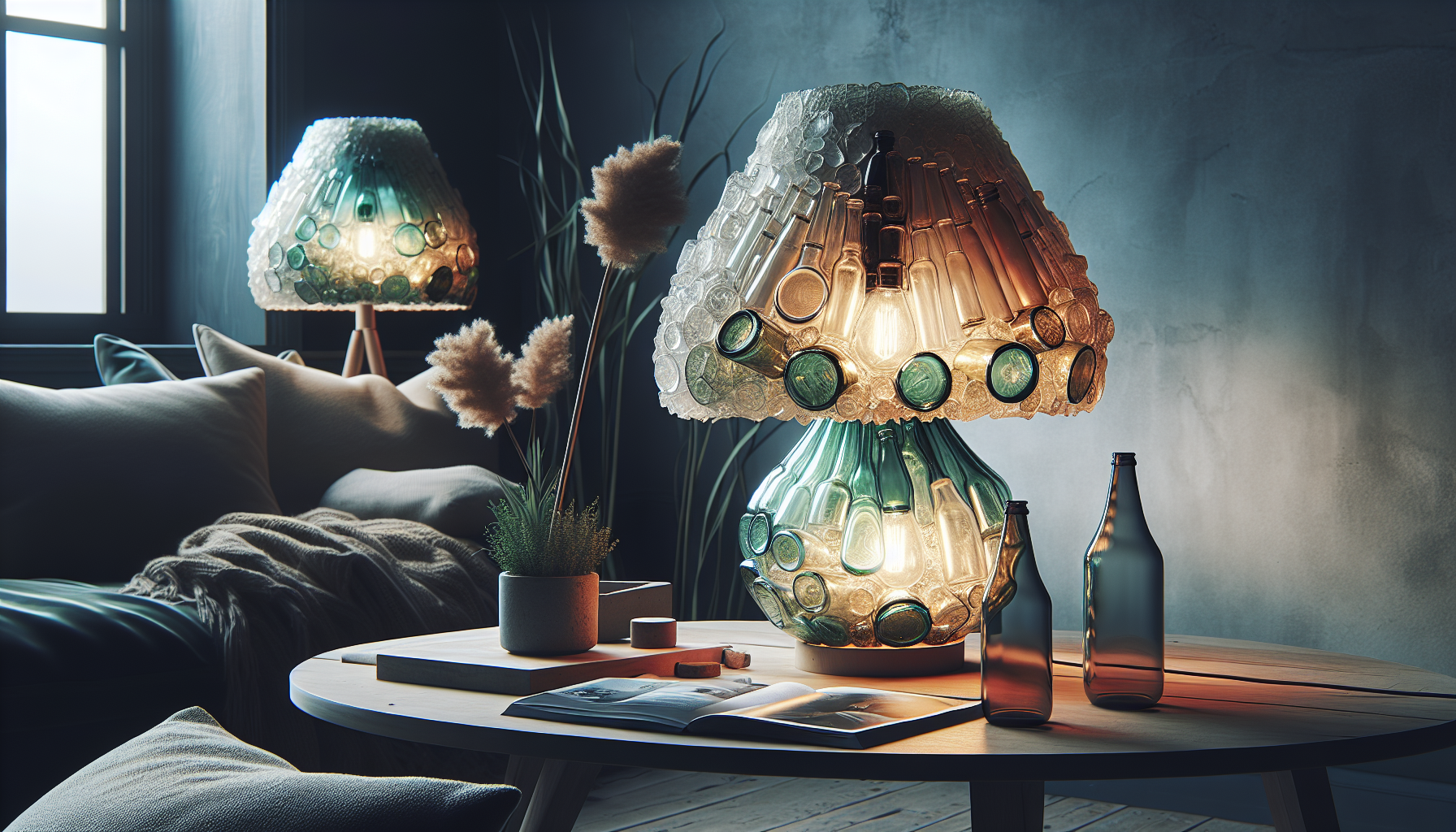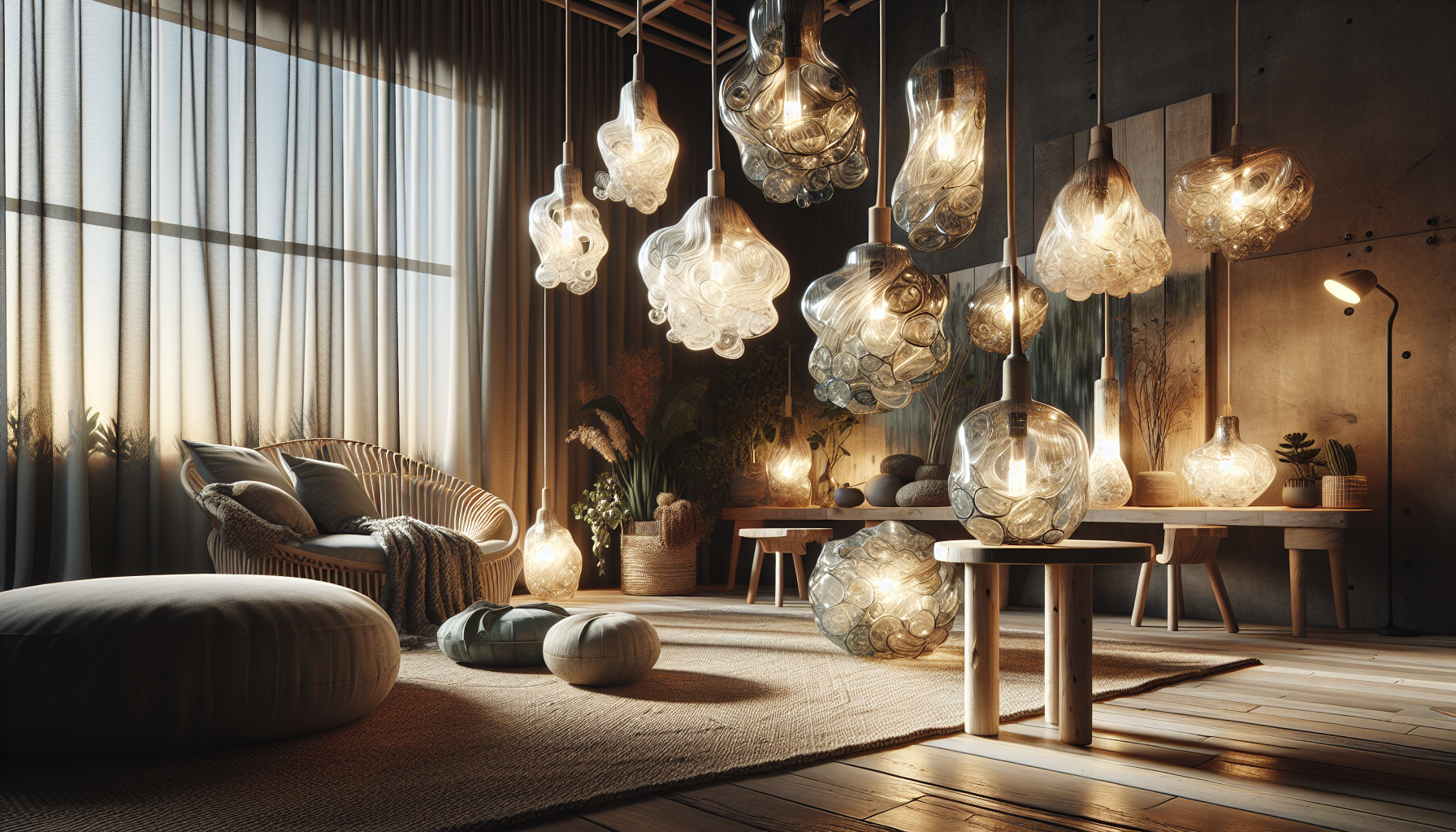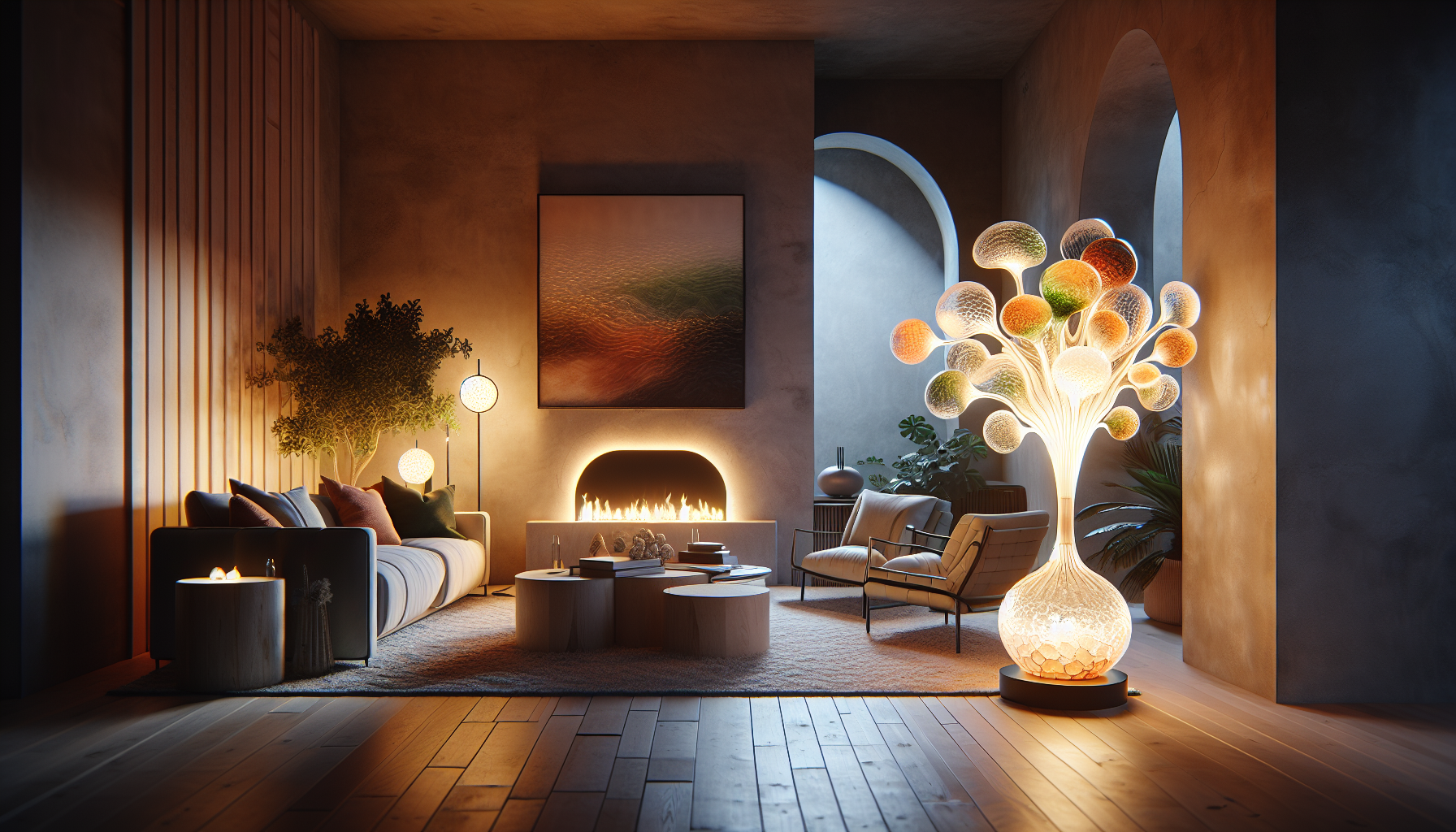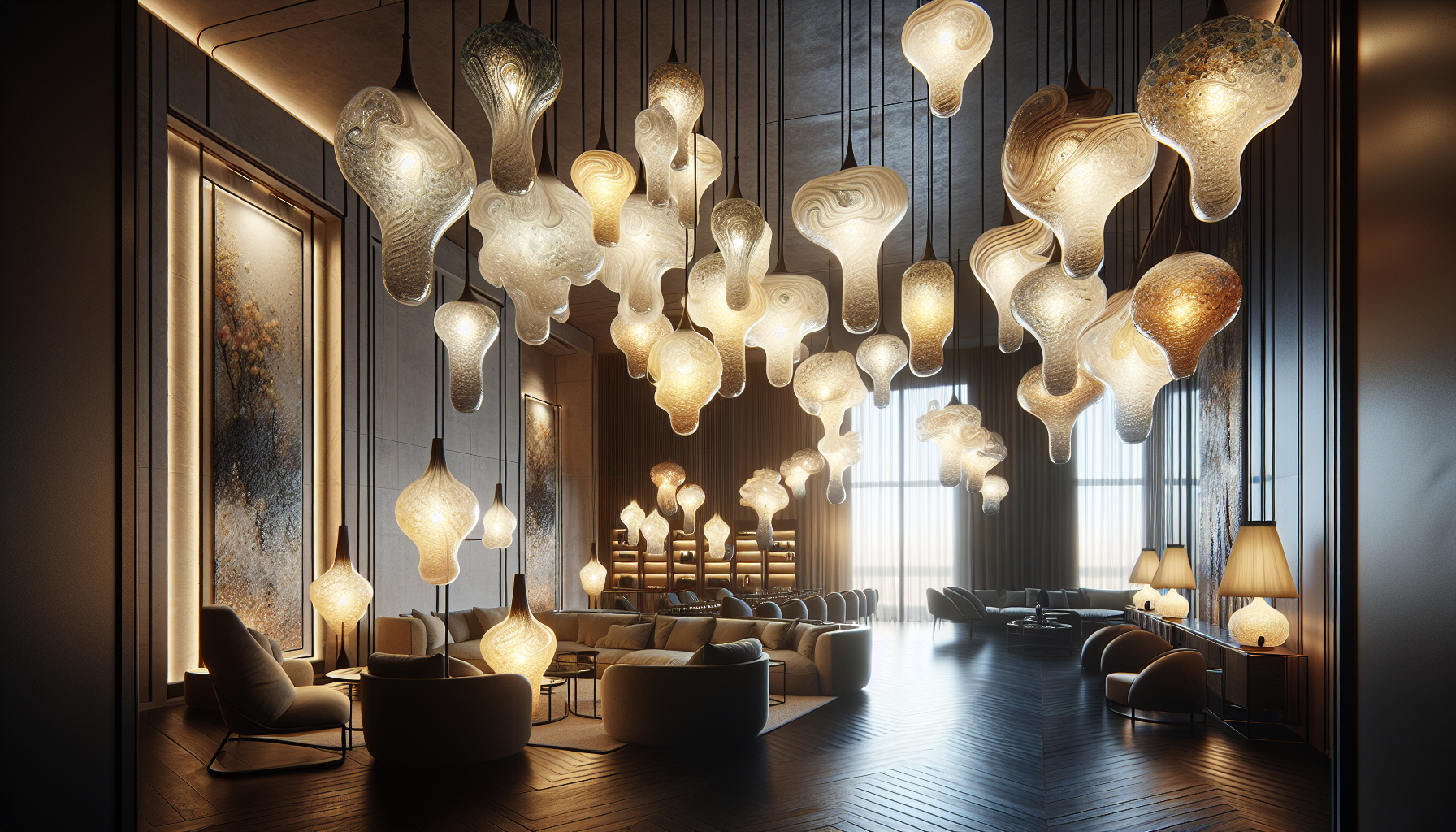In the gentle dance of light and shadow, where creativity meets sustainability, a unique form of artistry has emerged, breathing new life into discarded materials. This art form, a testament to human ingenuity and a beacon of environmental consciousness, is the creation of sculpted illumination through fused glass lamps, crafted lovingly from recycled bottles. These luminous masterpieces not only illuminate spaces but also tell a story of transformation, where ordinary glass bottles, often seen as mere waste, are reborn as objects of beauty and functionality. In this article, we delve into the world of these extraordinary lamps, exploring the intricate processes behind their creation, the artistry that fuels their design, and the broader impact they have on both our living spaces and our planet 🌍.
At the heart of this fascinating art lies the process of glass fusion, an ancient technique that has been revitalized to embrace modern sustainable practices. This process involves carefully selecting glass bottles of various colors and textures, which are then meticulously cleaned and prepared. The bottles are cut, arranged, and layered with precision before being subjected to the intense heat of a kiln. Here, the magic happens. The heat softens the glass, allowing it to meld and flow, ultimately fusing into a singular, cohesive piece. The result is a lamp that not only radiates light but also showcases a stunning array of colors and patterns, each piece as unique as a fingerprint. This intricate process, while labor-intensive, is a labor of love, driven by a desire to create beauty from the discarded and overlooked.
But these lamps are more than just functional art; they are a statement—a bold declaration of what can be achieved when sustainability meets creativity. In a world increasingly dominated by mass-produced goods, these handmade lamps stand as a reminder of the value of craftsmanship and the importance of thoughtful, intentional design. They serve as a testament to the potential of upcycling, transforming what was once waste into something of profound beauty and utility. Each lamp tells a story, not just of its own creation, but of the larger movement towards a more sustainable and responsible way of living. This movement encourages us to rethink our relationship with the objects around us, to see potential where others see waste, and to cherish the beauty of the handmade.
Throughout this article, we will explore the journey of these lamps from discarded bottle to glowing masterpiece, shedding light on the artists behind this movement and the inspiration that fuels their work. We will delve into the design principles that guide the creation of each lamp, examining how form and function are seamlessly intertwined to create pieces that are both aesthetically pleasing and practical. Furthermore, we will discuss the broader implications of this art form, considering how it contributes to the global conversation on sustainability and environmental stewardship. Join us as we illuminate the path from glass bottle to artful light, celebrating the creativity, innovation, and dedication that make these lamps a shining example of what can be achieved when art and sustainability come together in perfect harmony. 💡
Introduction to Sculpted Lighting: The Art of Fused Glass Lamps
The art of fused glass lamps is a captivating blend of creativity and sustainability, using recycled glass bottles as the primary material. This innovative approach not only helps in reducing environmental waste but also gives birth to stunning pieces of sculpted lighting. These lamps are more than just sources of light; they are artistic expressions that add character and ambiance to any space. The intricate designs, achieved through the fusion of glass, result in unique shapes and patterns that mesmerize anyone who lays eyes on them.
Fused glass art involves heating glass pieces until they melt and fuse together, forming a cohesive piece. This process requires precise control over temperature and timing to achieve the desired effects. Each lamp is a testament to the artist’s skill and vision, transforming ordinary glass bottles into extraordinary works of art. By utilizing recycled materials, these lamps also promote sustainable practices, making them a perfect choice for eco-conscious consumers looking to add an artistic touch to their homes or offices.
One of the most appealing aspects of fused glass lamps is their versatility. They can be crafted in various shapes, sizes, and colors, allowing artists to experiment with different designs and styles. Whether it’s a bold, colorful piece that serves as a focal point or a subtle, elegant lamp that complements the existing decor, there is a fused glass lamp for every taste and preference. As a result, these lamps have gained popularity among interior designers and homeowners alike, who appreciate their beauty and eco-friendly nature.
The Process of Creating Fused Glass Lamps
Creating a fused glass lamp begins with selecting the appropriate glass bottles. Artists often choose bottles with interesting colors or textures, as these characteristics will be highlighted in the final product. Once the bottles are selected, they are cleaned thoroughly to remove any labels, glue, or residue. This step is crucial to ensure the purity of the glass and the quality of the final lamp.
The next step involves cutting the bottles into smaller pieces, which will be arranged into the desired design. Artists use various tools and techniques to cut the glass, such as glass cutters, pliers, and grinders. The pieces are then meticulously arranged on a kiln shelf, where they are ready to be fused together. This stage is where the artist’s creativity truly shines, as they experiment with different arrangements and color combinations to achieve a unique and captivating design.
Once the design is complete, the glass pieces are placed in a kiln and heated to a temperature where they begin to melt and fuse together. This process can take several hours, depending on the complexity of the design and the thickness of the glass. As the glass cools, it hardens into a single, solid piece. The artist must carefully monitor the kiln’s temperature to prevent the glass from overheating or cracking. After cooling, the fused glass is removed from the kiln and cleaned to remove any kiln wash or residue.
Assembling the Lamp
After the glass has been fused and cooled, it’s time to assemble the lamp. The artist must drill a hole in the glass piece to accommodate the lamp’s electrical components. This step requires precision and care to avoid damaging the glass. Once the hole is drilled, the lamp base and electrical components are installed. The final step is to add a light bulb and test the lamp to ensure it functions properly.
The result is a stunning, one-of-a-kind lamp that combines artistic design with functionality. Each fused glass lamp is unique, as no two pieces of glass will melt and fuse in the exact same way. This uniqueness is one of the key attractions of fused glass lamps, making them a sought-after addition to any home or office.
Benefits of Using Recycled Glass in Fused Glass Lamps
Utilizing recycled glass bottles in the creation of fused glass lamps offers numerous environmental and aesthetic benefits. Recycling glass reduces the amount of waste that ends up in landfills, helping to conserve natural resources and reduce pollution. Additionally, using recycled materials in art encourages sustainable practices and raises awareness about the importance of recycling and environmental conservation.
From an artistic standpoint, recycled glass bottles offer a unique and diverse range of colors and textures that can be incorporated into the design of the lamps. Each bottle has its own history and characteristics, which adds to the uniqueness and charm of the final product. By using recycled glass, artists can create lamps that are not only beautiful but also environmentally friendly, making them a perfect choice for those who value sustainability and creativity.
Moreover, using recycled glass can be more cost-effective than using new materials, allowing artists to produce high-quality lamps at a lower cost. This affordability makes fused glass lamps accessible to a wider audience, allowing more people to enjoy the beauty and artistry of these unique lighting solutions.
Environmental Impact
The environmental benefits of using recycled glass in fused glass lamps are significant. Glass is 100% recyclable, meaning it can be recycled indefinitely without losing quality or purity. By reusing glass bottles, artists help reduce the demand for new glass production, which is an energy-intensive process. This reduction in energy consumption helps decrease greenhouse gas emissions and conserves valuable natural resources, such as sand and soda ash.
Furthermore, recycling glass bottles reduces the amount of waste that ends up in landfills, where it can take thousands of years to decompose. By repurposing these bottles into beautiful lamps, artists contribute to a more sustainable and environmentally conscious world.
Economic Benefits
The economic benefits of using recycled glass in fused glass lamps extend beyond cost savings for artists. The demand for eco-friendly products is growing, and consumers are increasingly seeking out sustainable and environmentally responsible options. By creating lamps from recycled materials, artists tap into this growing market and appeal to eco-conscious consumers who are willing to pay a premium for products that align with their values.
Additionally, the production of fused glass lamps creates jobs and supports local economies. From the collection and cleaning of recycled bottles to the creation and sale of the lamps, each step in the process contributes to the economy and provides employment opportunities for artists and artisans.
Design Variations and Aesthetic Appeal
The versatility of fused glass lamps is one of their most appealing features. Artists can experiment with a wide range of colors, shapes, and textures, resulting in lamps that are as diverse as they are beautiful. This versatility allows for endless design possibilities, ensuring that there is a fused glass lamp to suit every taste and style.
One popular design variation involves incorporating different colors of glass to create a mosaic effect. This technique involves arranging small pieces of colored glass in a pattern, which is then fused together to create a vibrant and eye-catching design. The use of contrasting colors and textures adds depth and dimension to the lamp, making it a striking addition to any room.
Another design variation involves creating lamps with intricate, sculptural shapes. This technique requires a high level of skill and precision, as the artist must carefully control the temperature and timing of the fusing process to achieve the desired shape. The result is a lamp that serves as both a functional lighting solution and a work of art.
Incorporating Patterns and Textures
Patterns and textures play a significant role in the design of fused glass lamps. Artists can create intricate patterns by arranging glass pieces in specific shapes or using techniques such as sandblasting or engraving to add texture to the surface of the glass. These patterns and textures catch and refract light, creating stunning visual effects that enhance the overall aesthetic appeal of the lamp.
The choice of pattern and texture can greatly influence the mood and ambiance of a room. For example, a lamp with a soft, frosted texture may create a calming and relaxing atmosphere, while a lamp with bold, geometric patterns may add a modern and dynamic touch to a space.
Customization and Personalization
One of the unique advantages of fused glass lamps is the ability to customize and personalize the design. Artists can work with clients to create lamps that reflect their personal style and preferences. This customization can involve selecting specific colors, shapes, or patterns, or incorporating meaningful symbols or motifs into the design.
Personalized fused glass lamps make thoughtful and unique gifts for special occasions such as weddings, anniversaries, or birthdays. They can also serve as commemorative pieces that hold sentimental value, making them cherished additions to any home.
Choosing the Right Fused Glass Lamp for Your Space
Selecting the perfect fused glass lamp for your space involves considering several factors, including the size and layout of the room, the existing decor, and the intended use of the lamp. By taking these factors into account, you can choose a lamp that not only enhances the aesthetic appeal of your space but also meets your functional lighting needs.
When choosing a fused glass lamp, it’s important to consider the size and scale of the lamp in relation to the room. A large, statement lamp may work well in a spacious living room or dining area, while a smaller, more delicate lamp may be better suited for a bedroom or office. The height and placement of the lamp should also be considered to ensure it provides adequate lighting and complements the overall design of the room.
Matching with Existing Decor
The design and color scheme of the fused glass lamp should complement the existing decor and color palette of the room. Consider the dominant colors and materials used in the space and choose a lamp that harmonizes with these elements. For example, a lamp with earthy tones and organic shapes may work well in a room with natural wood and neutral colors, while a lamp with bold colors and geometric patterns may complement a modern, minimalist space.
The style of the lamp should also align with the overall aesthetic of the room. A vintage or rustic lamp may add warmth and character to a traditional or farmhouse-style room, while a sleek and contemporary lamp may enhance a modern or industrial space.
Functional Considerations
In addition to aesthetic considerations, it’s important to think about the functional aspects of the lamp. Consider the type of lighting you need for the space and choose a lamp that provides the appropriate level of illumination. For example, a lamp with a soft, diffused glow may be ideal for creating a cozy and inviting atmosphere, while a lamp with a bright, focused beam may be better suited for task lighting.
It’s also important to consider the energy efficiency of the lamp. Many fused glass lamps are compatible with energy-efficient LED bulbs, which can help reduce energy consumption and lower electricity bills. Look for lamps that are designed to work with LED bulbs or consider upgrading the lamp’s components to accommodate them.
Maintaining and Caring for Your Fused Glass Lamp
Proper maintenance and care are essential to ensure the longevity and beauty of your fused glass lamp. While fused glass is durable and resilient, it requires regular cleaning and upkeep to keep it looking its best. By following a few simple guidelines, you can preserve the brilliance and artistry of your lamp for years to come.
Regular cleaning is essential to remove dust, dirt, and fingerprints from the surface of the glass. Use a soft, lint-free cloth or microfiber cloth to gently wipe the glass, avoiding abrasive materials that could scratch or damage the surface. For more thorough cleaning, you can use a mild glass cleaner or a mixture of water and vinegar. Be sure to avoid harsh chemicals or ammonia-based cleaners, as these can damage the glass and affect its appearance.
Handling and Safety Precautions
When handling your fused glass lamp, it’s important to exercise care and caution to prevent damage or injury. Always support the base of the lamp when moving it, and avoid lifting it by the glass or delicate components. Ensure that the lamp is placed on a stable, level surface to prevent tipping or falling.
If your lamp requires assembly or maintenance, be sure to follow the manufacturer’s instructions carefully. If you’re unsure about any aspect of the lamp’s assembly or operation, consult a professional for assistance. Additionally, ensure that all electrical components are properly installed and functioning to prevent electrical hazards.
Repair and Restoration
In the event that your fused glass lamp is damaged or requires repair, it’s important to address the issue promptly to prevent further damage. Depending on the nature and extent of the damage, you may be able to perform minor repairs yourself, such as replacing a bulb or tightening loose components. However, for more significant repairs, such as cracks or structural damage to the glass, it’s best to consult a professional artist or artisan with experience in fused glass restoration.
Restoration of fused glass lamps may involve re-fusing the glass or replacing damaged components. While this process can be complex and time-consuming, it can restore the lamp’s original beauty and functionality. Be sure to choose a qualified and experienced professional to perform the restoration, as improper techniques or materials can result in further damage to the lamp.
Conclusion: The Timeless Appeal of Fused Glass Lamps
The allure of fused glass lamps lies in their unique blend of artistry, sustainability, and functionality. These lamps are not only beautiful and captivating works of art but also environmentally responsible lighting solutions that promote the reuse and recycling of materials. By choosing a fused glass lamp, you not only enhance the aesthetic appeal of your space but also contribute to a more sustainable and eco-friendly world.
The intricate designs, vibrant colors, and sculptural shapes of fused glass lamps make them a striking addition to any room, whether as a focal point or a complementary piece. With endless design possibilities and the ability to customize and personalize the lamps, there is a fused glass lamp to suit every taste and style.
For those interested in learning more about the art of fused glass and exploring the creative possibilities of recycled materials, I recommend watching the video “The Art of Fused Glass” by Glass Artist Studio on YouTube. This video provides an in-depth look at the process and artistry behind fused glass creations and is sure to inspire both artists and enthusiasts alike.

Conclusion: Embracing the Art of Sculpted Illumination
In exploring the innovative world of sculpted illumination through fused glass lamps crafted from recycled bottles, we’ve ventured into a realm where sustainability meets art. This exploration has illuminated not only the transformative power of recycled materials but also the boundless creativity that defines this artistic endeavor. By recapping the salient points discussed, we reinforce the value of embracing such creative sustainability in our daily lives.
To begin with, we examined the foundational process of creating these unique lamps. This journey starts with the collection and careful selection of discarded glass bottles, each holding its own story and potential. These bottles undergo a meticulous cleaning and preparation process, readying them for the transformation into works of art. The technique of glass fusing then breathes new life into the material. By exposing the glass to controlled heat, artists are able to mold it into stunning, one-of-a-kind pieces that serve as both functional light sources and artistic statements.
Moreover, the discussion highlighted the intricate balance between functionality and aesthetics in these lamps. Unlike mass-produced lighting fixtures, each handcrafted lamp tells a story through its design and form. The interplay of light with the unique textures and colors of fused glass creates captivating visual effects, transforming any space into a gallery of light and shadow. This artistic approach not only enriches the environment but also serves as a conversation starter, inviting curiosity and admiration from all who encounter it.
A significant portion of our discussion focused on the environmental benefits of this art form. By utilizing recycled glass bottles, these lamps significantly reduce waste and promote sustainable practices. The emphasis on upcycling not only mitigates the negative impact of glass waste on the environment but also encourages a circular economy, where materials are continuously repurposed rather than discarded. This aligns with broader global efforts to combat climate change and preserve natural resources for future generations.
The artists behind these creations are
Toni Santos is a lighting artisan and visual explorer who designs atmospheres, not just objects. With a refined sensitivity to form, reflection, and emotion, Toni’s work at Sordux is an ode to how light transforms space, feeling, and story.
Through his handcrafted creations — from artistic glass bottles to radiant lighting totems — Toni invites us to see light as more than function. To him, light is symbolic. It is memory, energy, and meaning in motion.
Drawing inspiration from modern minimalism, ancestral aesthetics, and organic shapes, Toni blends natural materials with ambient expression. His collections are not just decorative — they’re immersive experiences, each one crafted to awaken the senses and reconnect us to the spaces we inhabit.
As the mind behind Sordux, Toni curates a world where illumination becomes ritual, and where every design element — from the curvature of a bottle to the hue of a glow — speaks of intention and presence.
🔥 His vision shines through:
-
Designs that merge mood with form
-
Bottled light as symbolic storytelling
-
Sustainable aesthetics rooted in artistic function
Whether you’re a designer, a dreamer, or someone who understands that light is a language of its own, Toni invites you into a world where glow becomes meaning, and every beam is an invitation to feel.





